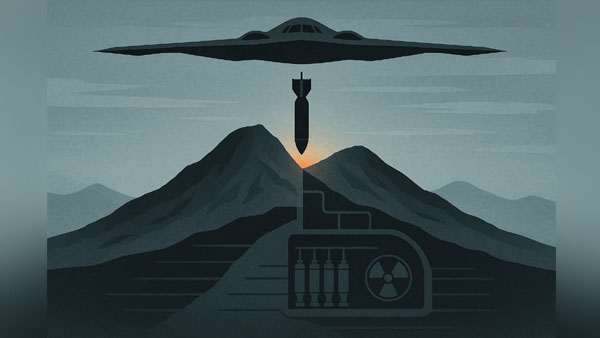The Bomb and the Bomber Israel Didn’t Have
By Dipak Kurmi
In a bold and consequential escalation of the conflict in the Middle East, former US President Donald Trump confirmed that the United States has conducted coordinated airstrikes on three critical nuclear sites in Iran. This marks a turning point in the ongoing conflict involving Israel and Iran, as it is the first known use of America’s most formidable non-nuclear weapon—the GBU-57 Massive Ordnance Penetrator (MOP)—against Iran’s heavily fortified underground nuclear facilities.
The centerpiece of the latest strikes was the Fordo uranium enrichment facility, a site that has long troubled Western intelligence agencies. Located approximately 90 metres beneath a mountain near the city of Qom, Fordo has been a focal point of global concern over Iran’s suspected pursuit of nuclear weapons. Previous Israeli attempts to neutralize Fordo had failed, primarily due to the site’s depth and structural reinforcements. However, the United States, with its unmatched military hardware, has now taken the step Israel could not—dropping a full payload of MOPs on the elusive target.
The Fordo Enrichment Facility: An Impenetrable Bastion
Built into the heart of a mountain and reinforced with tons of concrete and steel, Fordo has symbolised Iran’s defiance and strategic depth. The facility is believed to have housed a covert uranium enrichment program that many Western nations suspected was designed for nuclear weapons development. Despite numerous inspections and denials from Tehran, the site’s militarised design and inaccessible location suggested otherwise.
Fordo’s depth made it virtually invulnerable to conventional attacks. But now, after the joint Israeli-American targeting of Iran’s other major sites—Natanz and Esfahan—the attention has finally turned to Fordo with a level of force previously unseen.
The GBU-57 MOP: America’s Deep Strike Capability
At the heart of this strategic operation lies the GBU-57 Massive Ordnance Penetrator, a bomb that was tailor-made for precisely this kind of mission. Developed by the US Air Force Research Laboratory in collaboration with Boeing, the MOP is considered the most powerful non-nuclear weapon in existence.
Weighing approximately 13,000 kilograms and measuring over 20 feet in length, the MOP is designed to burrow into hardened underground facilities before detonation. According to official specifications, it can penetrate up to 60 metres of earth or fortified concrete—capabilities unmatched by any conventional munition in the global arsenal. The warhead’s high-performance steel alloy casing ensures the bomb maintains its structural integrity until it reaches its designated depth.
Originally developed after the 2003 Iraq War—where earlier bunker busters like the BLU-109 proved inadequate against fortified underground sites—the MOP was conceived as a non-nuclear alternative for defeating deeply buried weapons of mass destruction. After successful testing in 2007 and multiple production contracts awarded to Boeing, at least 20 of these bombs were delivered to the US Air Force. With its deployment over Fordo, the MOP may have now fulfilled its original mission statement.
The B-2 Spirit: Stealth Bomber Behind the Strike
Delivering the MOP required an aircraft with unique capabilities—long range, stealth, and enormous payload capacity. That aircraft was the B-2 Spirit, the US Air Force’s most advanced heavy strategic bomber. Built by Northrop Grumman with key contributions from Boeing, Hughes Radar Systems, and others, the B-2 is a symbol of American air dominance and technological prowess.
First introduced into service in 1997, only 21 of these aircraft were ever built, with an operational fleet of 19 currently active. Each aircraft, costing nearly $1.2 billion, is designed for deep penetration of enemy defenses, with a radar-evading flying wing design and advanced stealth technologies that include reduced infrared, acoustic, visual, and radar signatures.
The B-2’s capability to evade sophisticated air defenses and carry two MOPs simultaneously makes it the only aircraft capable of executing a mission like the Fordo strike. With an unrefueled range of over 9,600 kilometers and the ability to fly over 19,000 kilometers with in-flight refueling, the B-2 is a global strike weapon that can take off from the continental US, attack anywhere in the world, and return—all without detection.
The B-2 has a long and decorated history of successful missions, from Kosovo in 1999 to Afghanistan, Iraq, Libya, and now Iran. During Operation Allied Force in Serbia, the B-2 was responsible for 33% of all Serbian target destruction within the first eight weeks. In Iraq and Afghanistan, it carried out high-precision bombings while returning safely across oceans.
Trump’s Announcement and Strategic Implications
In a Truth Social post, former President Donald Trump publicly confirmed that the US dropped a “full payload of bombs” on Fordo. While the precise damage remains under assessment, the symbolic and strategic message is loud and clear—the United States is willing to deploy its most elite conventional capabilities to strike at the heart of Iran’s nuclear infrastructure.
Trump’s declaration further underlines the coordination, or at the very least alignment, between US and Israeli military strategies. Israel, though technologically advanced, lacks the munitions and aircraft needed to target ultra-deep facilities like Fordo. The deployment of MOP by the US bridges that gap, achieving what Israeli Air Force strikes on Natanz and Esfahan had only partially managed.
Fallout and Uncertainties
The true extent of the damage at Fordo remains shrouded in uncertainty. Given the site’s depth—approximately 90 metres underground—even the MOP may not have reached all enrichment chambers. However, military analysts believe the attack likely disrupted centrifuge operations and power infrastructure, setting back Iran’s nuclear ambitions by months, if not years.
Iran has yet to issue a comprehensive response, though heightened military alertness and renewed threats against both Israeli and American interests can be expected. The strikes are likely to inflame tensions not just between Iran and the West, but also across an already volatile Middle East. Hezbollah, Iran’s proxy in Lebanon, and Iranian-backed militias in Iraq and Syria may also be mobilised in retaliation.
Meanwhile, the international community faces a renewed nuclear crisis. Tehran, long accused of using civilian enrichment as a cover for weapons development, may now move to exit the Non-Proliferation Treaty or ramp up clandestine operations elsewhere. The Biden administration, if involved or complicit in the operation, has yet to issue an official statement, leaving strategic ambiguity in its wake.
A New Chapter in Covert Warfare
The use of the B-2 and the MOP against Fordo marks a historic moment in military strategy. It underscores the evolving nature of warfare—where technology, precision, and stealth take precedence over mass troop deployments. It also reaffirms that in the era of nuclear brinkmanship, non-nuclear deterrents like the MOP play a critical role in keeping conflict below the threshold of total war.
Yet, the implications of this action are vast. While it may delay Iran’s nuclear timeline, it may also accelerate the geopolitical race for similar deep-penetration weapons by other powers like China and Russia. For Israel, the strike is a relief—a long-sought strategic blow finally delivered. For Iran, it’s a harsh reminder that no bunker is truly safe.
As the world watches the fallout from the Fordo strike, one thing is clear: the line between deterrence and escalation has blurred, and the era of high-tech, high-stakes warfare has entered a dangerous new phase.
(the writer can be reached at dipakkurmiglpltd@gmail.com)




